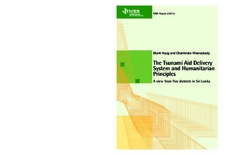| dc.contributor.author | Haug, Marit | |
| dc.date.accessioned | 2020-06-21T16:31:44Z | |
| dc.date.accessioned | 2021-04-29T13:15:44Z | |
| dc.date.available | 2020-06-21T16:31:44Z | |
| dc.date.available | 2021-04-29T13:15:44Z | |
| dc.date.issued | 2007 | |
| dc.identifier.isbn | 978-82-7071-701-9 | |
| dc.identifier.issn | 1502-9794 | |
| dc.identifier.uri | https://hdl.handle.net/20.500.12199/5699 | |
| dc.description.abstract | This report analyses the delivery of tsunami aid in Sri Lanka through international non-governmental organizations and the interface between the international aid delivery system and Sri Lankan governance institutions, civil society organizations and communities. Collaboration between international aid agencies and Sri Lankan civil society organizations worked out relatively well. Most agencies were also aware of the need to involve communities. Yet, few had found ways of effectively ensuring community participation. Local governance institutions were initially very active in the recovery effort, but later on their role was largely reduced to facilitating the work of aid agencies. Tilknyttet prosjekt Lankesiske institusjoners håndtering av bistand etter tsunamien | no_NB |
| dc.publisher | Oslo: Norwegian Institute for Urban and Regional Research | |
| dc.relation.ispartofseries | NIBR-rapport 2007:05 | |
| dc.subject | NIBR | |
| dc.title | The Tsunami Aid Delivery System and Humanitarian Principles | no_NB |
| dc.type | Report | |
| fagarkivet.author.link | https://www.oslomet.no/om/ansatt/marhau/ | |
